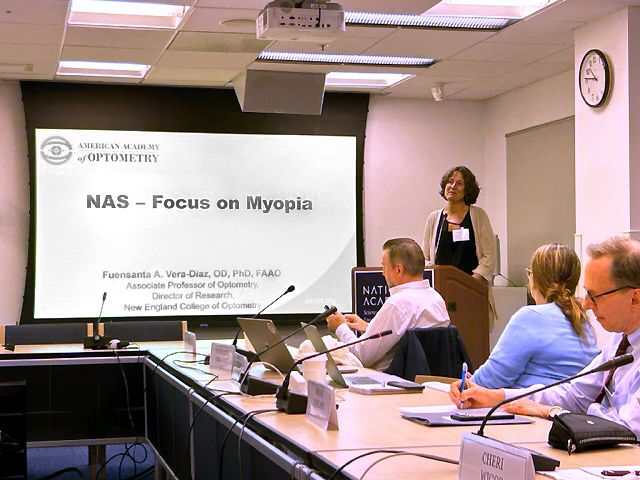The American Academy of Optometry (AAO) selected Dr Vera-Diaz to represent them at National Academies of Sciences, Engineering, and Medicine
Fuensanta A. Vera-Diaz, OD, PhD, FAAO, Director of Research and Associate Professor of Optometry at the New England College of Optometry (NECO) repersented AAO at the first meeting of the Committee on Focus on Myopia.
Dr Vera-Diaz presenting on Myopia at the American Academy of Optometry (AAO)

The American Academy of Optometry (AAO) asked Fuensanta A. Vera-Diaz, OD, PhD, FAAO, Director of Research and Associate Professor of Optometry at the New England College of Optometry (NECO) to speak on their behalf at the first meeting of the Committee on Focus on Myopia. The meeting was in an open session on July 18, 2023, in Washington, D.C. at the national academies of Science, Engineering, and Medicine (NASEM).1
A committee was formed by the National Academies Board on Behavioral, Cognitive, and Sensory Sciences to deliver a consensus study on findings, conclusions, and recommendations on myopia. Daniel Weiss, of the National Academies, will be leading the board, and it’s co-chaired by Terri Young, Chair of the Department of Ophthalmology and Visual Sciences at the University of Wisconsin-Madison, and Kevin Frick, Professor at John Hopkins Carey Business School.
Myopia impacts both temporal and spatial visual performance, even when vision is corrected by contact lenses, refractive surgery, or glasses. A key concern, of even low levels, of myopia are the high-risks of blinding diseases.
Fuensanta A. Vera-Diaz, OD, PhD, FAAO, Director of Research and Associate Professor of Optometry at the New England College of Optometry (NECO)

Dr. Vera-Diaz stated, “We must close the gaps in our knowledge regarding the etiology of myopia and the mechanisms behind the currently available treatments for myopia if we want to improve treatments and prevent myopia altogether, which should be the goal.”
Dr Vera-Diaz went into further detail on the need for experimental studies to answer the following questions:
- Which children will benefit from treatments that slow the progression of myopia? How much will they benefit?
- How can we accurately measure the success of myopia control treatments?
- How and why do treatments, including spectacles, contact lenses, surgical, pharmacological, and red-light therapy, work at the molecular, cellular, and visual level?
- What aspects of being outdoors are protective against myopia?
- How can we accurately measure the success of myopia control treatments?
- Can current myopia control treatment trial results be extrapolated to other demographics?
The AAO main priorities that will lead to the ultimate goal of preventing myopia for the NASEM Statement of Task include:
- Providing independent, objective, biased-free, evidence-based information that clinicians can easily access, interpret and trust.
- Promote studies that strive to understand the cause of myopia, which will lead to more effective, useful and accessible programs and treatments to control myopia.
- Educate clinicians and the public that myopia is a significant public health concern and that action is needed.
“On behalf of the American Academy of Optometry, we thank Dr. Vera-Diaz for representing our organization and our patients. This is an exciting NASEM initiative designed to address the current mechanistic understanding of myopia pathogenesis, identify knowledge gaps, and develop a research agenda to better understand the biological and environmental factors that cause myopia. We look forward to NASEM’s report,” said Dr. Susan A. Cotter, OD, MS, FAAO, President, American Academy of Optometry.
References
1. National Acadamies focus on myopia holds first open session. August 14, 2023. Accessed August 16, 2023. https://www.neco.edu/news/dr-vera-diaz-represents-the-aao/
Newsletter
Want more insights like this? Subscribe to Optometry Times and get clinical pearls and practice tips delivered straight to your inbox.